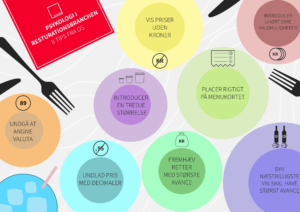01 Mar The restaurant industry can learn this from supermarket psychology

RESTAURANTPSYKOLOGY | Reading time: 10 min.
The restaurant industry can learn this from supermarket psychology
Written by Jens-Kristian
Psycology is important in the efforts of increasing your turnover. Read more here and get 8 tips to how you can use psycology in practice.
We all know that we as consumers are tempted to buy more than planned when we pass the local supermarket. Nothing is random here, and many different tricks are used, all with the intention of getting us to spend as much money as possible. It’s called supermarket psychology.
What fewer people know is that psychology can also be used to a great extent in the restaurant industry to influence guests to buy more. It’s called restaurant psychology and is all about getting the guest to spend more money or buy more unconsciously and impulsively.
Supermarket and restaurant psychology plays on many of the same keys, working with colors, shapes, locations, prices and much else that is intended to stimulate our urge to buy.
Here we will review some concrete and simple measures that you can implement in your restaurant with minimal cost and time, and increase your top and bottom line. The subject is huge, so this post will focus exclusively on how, with small changes to your menu, you can harness the wondrous powers of psychology and achieve noticeable results.
1. Show your prices without “kroner” or other currencies
We all know the oldest trick in the book of pricing goods with decimals instead of stating the price in whole numbers – such as DKK 9.95 – especially from the supermarket. In this way, consumers perceive the product as being cheaper than it really is, and are therefore more likely to buy the product. It is probably too much to start playing with decimals in the restaurant industry, but there is a big psychological difference between whether the starter with the white wine-steamed mussels is priced at DKK 90 or DKK 89.[/vc_column_text]
2. Avoid showing the currency
Once the price has been determined, it is advantageous not to have prices followed by the local currency. ’89’ seems cheaper than ’89 kroner’, as you do not draw the consumer’s focus towards the monetary, but instead keep them in relation to a relative value, which in the consumer’s eyes is not necessarily equal to kroner.
3. Avoid prices with decimals
If you would like to further avoid drawing the guest’s focus towards the monetary, then for all intents and purposes avoid specifying a price with decimals – such as 89.00 – as it emphasizes that it is about kroner.
4. introduce outragesly expensive options
If you wish to go all-in you have to introduce a couple of outragesly expensive options in your menu. This will make the rest of the options look a lot cheaper and make it seem like a bargain against the expensive options. It’s called ’price anchoring’ and it referring to the anchoring of a price in the consumers conscience. Prices are relative and nothing, in reality, is cheap or expensive. These ‘price anchors’ have the purpose to set the bar high to create an illusion in the consumers conscience, that other options are cheaper even if they in reality aren’t.
5. Place things right on the menu
The placement of your price anchors can also have a big impact on how well the prices are anchored in the guest’s mind. Scientific studies show that our eyes are drawn to the upper right corner, as the first thing, when we see a menu. Therefore price anchors can, with advantage, be used in the top right corner, so it will be the first thing the customer see. This will help create the relative conception that the other dishes are cheaper because the price anchor is the basis for the comparison. You could also be lucky that the customer is tempted by the price anchor and chooses to buy that.
6. Highlight the dishes with the biggest markup
There is a big difference in where you as a restaurateur has the biggest markup. It’s coomonly known that restaurateurs usually have a big profit on drinks, men there is typically a big difference on which dishes have the biggest markups. You’ll of course want to sell the dishes with the biggest markups, and that’s why it makes good sense to draw the customers attention towards these dishes.
It can be a big advantage to highlight these dishes on the menu. You can do that by giving these dishes a bigger font size than the rest, highlight the dish with a bold font, a special color or anything like that – but you can also give them appetizing names such as ‘Grandma’s Tartlets’ or ‘Tartlets as grandma used to make them’ instead of just tartlets.
If you don’t want to use price anchors you can place the dishes with the biggest markup in the top right corner, so that will be the first thing the customer notices on the menu, and the customer is more likely to choose one of those.
7. Your second cheapest wine has to have the biggest markup
Speeking of markups. Few of us want to be perceived as stingy, and this is especially true when we go out to eat. This is why we don’t want to order the cheapest wine, but go for the second cheapest instead. Because then we can’t be perceived as stingy, we think. Therefore, it makes very good sense for restaurateurs, that sells wine, that the second cheapest wine on the wine list is the one with the biggest markup.
8. Introduce a third size
It is also not without significance whether you offer the guest two or three different sizes of soda and beer. If you offer e.g. two sizes of soda; a small one of 0.33 liters for DKK 35 and a large one of 0.5 liters for DKK 50, guests will be less inclined to choose the large one for DKK 50. If, on the other hand, you introduce a third size – e.g. of 0.7 liters for DKK 65. – your customer will be more likely to choose the middle size. So now the customers will choose a soda of 0.5 liters more often, than when you only offered two sizes.
This was a sample of how you can increase your top and bottom line using small psychological tricks. There are of course many other initiatives that stem from restaurant psychology that you can use to your advantage, so we encourage you to go on a further discovery of how you can actively use psychology to optimize your business.
